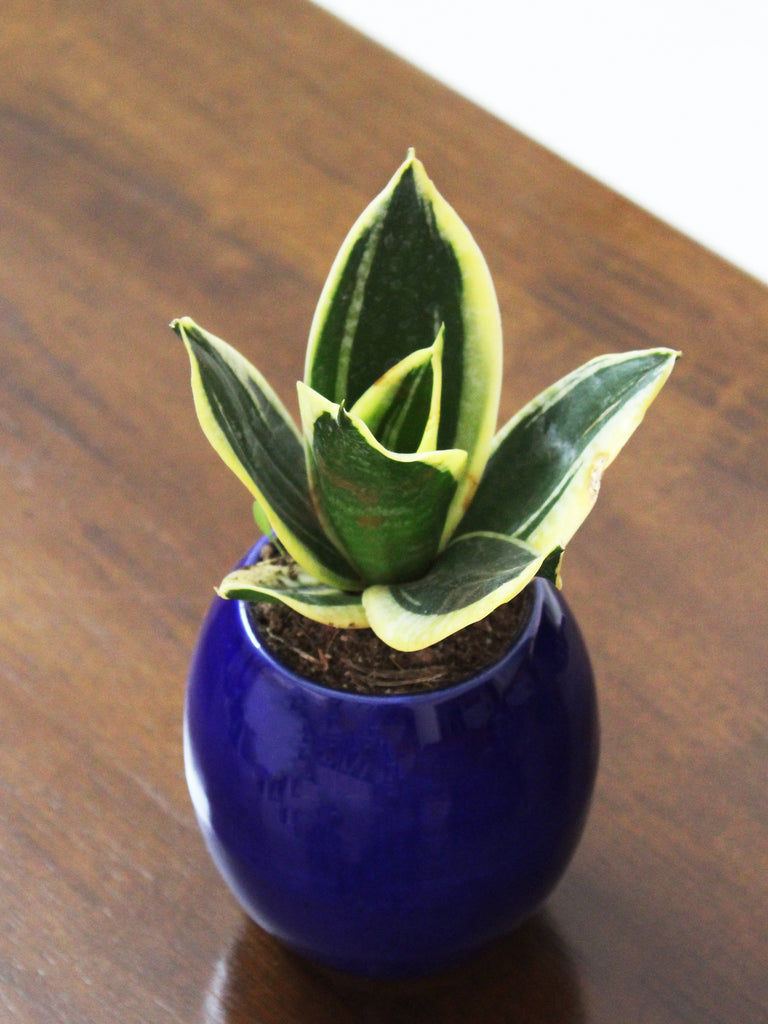The snake plant or Sansevieria pronounced (san-se-vi-ee’-ri-ah) a member of the Lily Family, popularly goes by other common names. The very “politically correct” Mother-in-Law’s tongue and Bowstring-hemp. The durability of Sansevieria makes it an excellent choice for apartment dwellers that often have limited success with houseplants due to lighting issues. They should take a good look at the snake plant. Sansevieria tops the list as being the most tolerant of all decorative plants to survive the most unsuitable growing conditions, abuse and neglect a plant could receive. Basically, you have to work really hard to kill sansevieria. Snake plant is classic yet versatile houseplant with sword like foliage design. It is excellent for the forgetful gardener and its considered a top air purify plant for indoor environment.
Before we move forward to know more about Snake plants, here is a snake plant in high quality ceramic pot which you can purchase directly from Amazon:
Air Purifier Approved by NASA
The Sansevieria is an ideal plant for indoor spaces because it is a superb air purifier. Studies, including those performed by NASA, have consistently shown the plant to remove toxins such as formaldehyde, xylene, toluene, and nitrogen oxides—which means that industries and workspaces such as automotive plants and shops, aircraft plants, plywood, carpeting, paint makers and sellers, printing, and offices, where these chemicals abound in the products produced and used, would greatly benefit by keeping several Sansevieria around. NASA, whose study purposed to determine how to clean the air in space stations, recommends at least 15 to 18 medium-to-large size plants for a 1,800 square-foot home.
Releases Night Time Oxygen
Snake Plant a.k.a. Mother-In-Law’s Tongue (MILTs): Of all the different oxygen producing plants, this one is unique since it converts a lot of CO2 (carbon dioxide) to O2 (oxygen) at night, making it ideal to have several in your bedroom. 6-8 plants are needed per person to survive if there is no air flow (meaning you could live in a completely air sealed room if you had these plants). The snake plant also removes formaldehyde from the air.
Most plants largely uptake Carbon dioxide (CO2)and release oxygen during the day (photosynthesis) and uptake oxygen and release CO2 during the night (respiration).
Above plants can uptake CO{-2} during the night as well because of their ability to perform a type of photosynthesis called Crassulacean Acid Metabolism (CAM).
There are 2 pathways in photosynthesis.
Light reactions where O2 is released by splitting H2O.
Dark reaction (Calvin Cycle) where CO2 is used to make sugars.The energy to drive these reactions come from sunlight. CO2 is absorbed via stomata, and O2 is released by the same stomata. In CAM photosynthesis, or Crassulacean-Acid metabolism, the plant opens the stomata at night to minimize water loss. CO2 is acquired at this time, and stored in vacuoles as malate.
Helps fight Allergies and Sick Building Syndrome
Snake plant absorbs toxins and releases oxygen. The plant may releases moisture in the air and lessens airborne allergens. The Sansevieria meets these conditions perfectly.
Persons with allergies, therefore, should find a friend in such plants because they are a natural and cheap way to stay healthy. Further, public spaces and workplaces, especially, should be aware of the value of air-purifying plants for these reasons. Sick building syndrome (SBS) describes the way the health of certain individuals of a certain residence or building acquires moderate to acute symptoms that are linked to the building while no specific illness can be identified.
Most of the symptoms involved with SBS appear to be related to poor indoor air quality. They include ear, nose, and throat irritation; coughing; itching; dizziness and nausea; lack of concentration; fatigue; even chest tightness and muscle aches. But the symptoms leave not long after individuals have departed the building.
Now there are a few things that plausibly explain this, like ventilation that doesn’t properly distribute air; chemicals from carpets, upholstery, copy machines, pesticides, and cleaning agents; outside pollutions being pumped in; bacteria, molds, and viruses. Do you see the alarming link between these explanations and formaldehyde, xylene, toluene, and nitrogen oxides? The Sansevieria is a ready remedy for SBS.
Feng Shui & Placement
The Snake plant purifies air by absorbing toxins through the leaves and producing pure oxygen. In fact, the Sansevieria is an ideal bedroom plant. Whereas most other plants release carbon dioxide at night (in the absence of photosynthesis), the Sansevieria continues to produce oxygen.
Also known as mother-in-law’s tongue, this plant is one of the best for filtering out formaldehyde, which is common in cleaning products, toilet paper, tissues and personal care products. Put one in your bathroom — it’ll thrive with low light and steamy humid conditions while helping filter out air pollutants.
Sometimes the Mother-in-Law's Tongue plant, also called the Snake Plant (Sansevieria trifasciata) is considered a bad Feng Shui plant. However, this is not true, because the Snake Plant can bring very helpful feng shui energy when needed in specific areas of a home or office; this plant has strong protective energies. Spiky plants like snake plants are excellent for shielding you against negative Chi, but their aggressive energy means you need to place them where they’re not in highly-trafficked areas of your home. The snake plant is a perfect expression of upward, growing ch’i. The strong wood energy cuts through negative or stagnant energy. The best position to place the plants in your office or home is a place that is enriched by the plant's Wood element. Southeastern, Southern, and Eastern corners are the best feng shui spots to place your plants.
The Chinese used to grow this plant in their houses, as a valuable house plant, since the Eight Gods conferred their eight virtues as gifts, to all those who possessed this plant. The eight virtues are prosperity, beauty, long life, intelligence, health, art, strength and poetry. They placed the plants close to the entrance within their home for the purpose of enabling the eight virtues to enter according to pre-Feng-Shui.
Hard to Kill & Easiest to Maintain
Snake plant care is very straightforward. These plants can be neglected for weeks at a time; yet, with their strappy leaves and architectural shape, they still look fresh.
They really are the easiest of plants to look after, and will happily reward your lack of attention by giving clean air to your home and a little cheer in the corner of any room. If You Want A Houseplant That:
- Is tough indoors
- Can be placed just about anywhere
- Takes up little space
- Goes a long time between watering
- A good starter plant for the house
- Can start outside in spring and move inside
How to Care?
Light:The mother in laws tongue is well known for coping with direct sun and low light conditions, although bright light conditions with some sun light and shade is preferred.
Water:Be cautious when watering, especially during the winter, better to err on the dry side. Watering is usually a matter of personal judgment. I water my snake plants whenever they seem to need it, about every 2-3 weeks. Few plants should be kept constantly wet, fewer should ever be allowed to suffer from lack of moisture. Keep leaves clean and free from dust and grease. Other care consists of keeping the plants moist but not wet, and feeding occasionally. Because this plant is a succulent it stores water within its foliage, so it is not necessary to keep the soil damp. Water from spring to fall when the soil becomes dry to the touch and during the winter only once a month. Be careful not to over water as this can cause the root and base of the plant to rot.
With its interesting foliage and ease of growing, the snake plant is one of the most popular air purifying plants. It has been scientifically proven that snake plant can absorb poisonous gases in the air and releases night time oxygen. It will give a natural humid atmosphere around you along with being anti-allergic and fighting Sick Building Syndrome. Now we also know that it’s also lucky to have it in home and office. This makes it a perfect pick. Adding snake plants will provide you with an added benefit of keeping interiors beautiful and healthy.
Author: Vandana Chaudhary



26 comments
Thanks for a great read! I just transplanted 8 Snakes and wondered where to put them😎👍
Very helpful information and a very complete overview of all things MILT. Thank you for sharing this information! Now to decide how to refer to this plant…”snake plant” or “mother in law’s tounge”…I don’t know which nickname is less creepy…ha…
Really Nice one, thanks alot for all the informations you have provided.
Great content.
I’ve been surfing online more than 4 hours today, yet I never found any interesting article like yours.
It is pretty worth enough for me. In my view, if all webmasters and bloggers
made good content as you did, the net will be much more useful than ever before.
Hey there would you mind stating which blog platform you’re using?
I’m looking to start my own blog soon but I’m having a tough time making a
decision between BlogEngine/Wordpress/B2evolution and Drupal.
The reason I ask is because your design seems different then most blogs and I’m looking for something completely unique.
P.S Sorry for getting off-topic but I had to ask!
Greetings from California! I’m bored to tears at work so I decided to check out your site on my iphone during
lunch break. I love the information you provide here and
can’t wait to take a look when I get home. I’m
shocked at how fast your blog loaded on my mobile ..
I’m not even using WIFI, just 3G .. Anyways, fantastic
blog! http://linux.com/